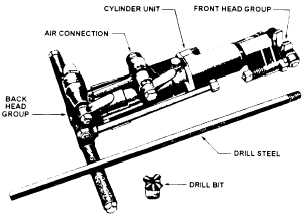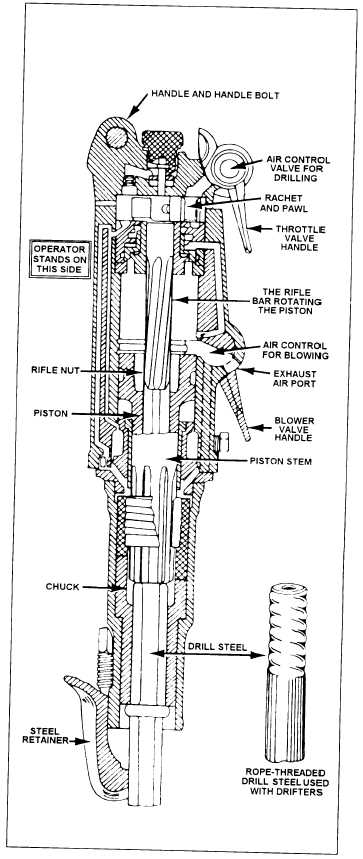HAND-HELD ROTARY ROCK
DRILL/JACKHAMMER
The hand-held pneumatic rock drill/jackhammer
(fig. 14-15) is a piston rotary unit that is designed mainly
for use as a hard rock drill; however, it is equally
efficient in soft and medium formations.
The components of the drill are shown in figure
14-16. The drill consists of a back head group, cylinder
unit, and front head group. The back head group
consists of the four-position throttle, handle, and live air
inlet. The cylinder unit consists of a cylinder with a
reciprocating piston. The front head group consists of
the chuck, retainer latch, and anvil. The drill design
directs air through the drill, down the drill steel, and into
the bottom of the hole to blow out rock cuttings.
Four classes of rotary rock drills/jackhammers are
as follows:
. The first class is a light drill, weighing about
15 pounds. This class is used for drilling shallow holes
in quarry operations.
l The second class is a light drill, weighing 25
to 40 pounds. This class is used for light work, such as
potholing and drilling concrete.
. The third class weighs from 40 to 50 pounds.
This class is used for drilling in limestone and other soft
rock.
. The fourth class is a hand-held drill, weighing
from 50 to 65 pounds. This class is used for drilling
holes up to 6 feet during quarry operations.
NOTE: All of these drills use hollow drill steel and
are built with automatic rotation.
Figure 14-15.—Hand-held rotary rock drill/jackhammer.
Figure 14-16.-Components of a hand-held rotary rock
drill/jackhammer.
14-12



